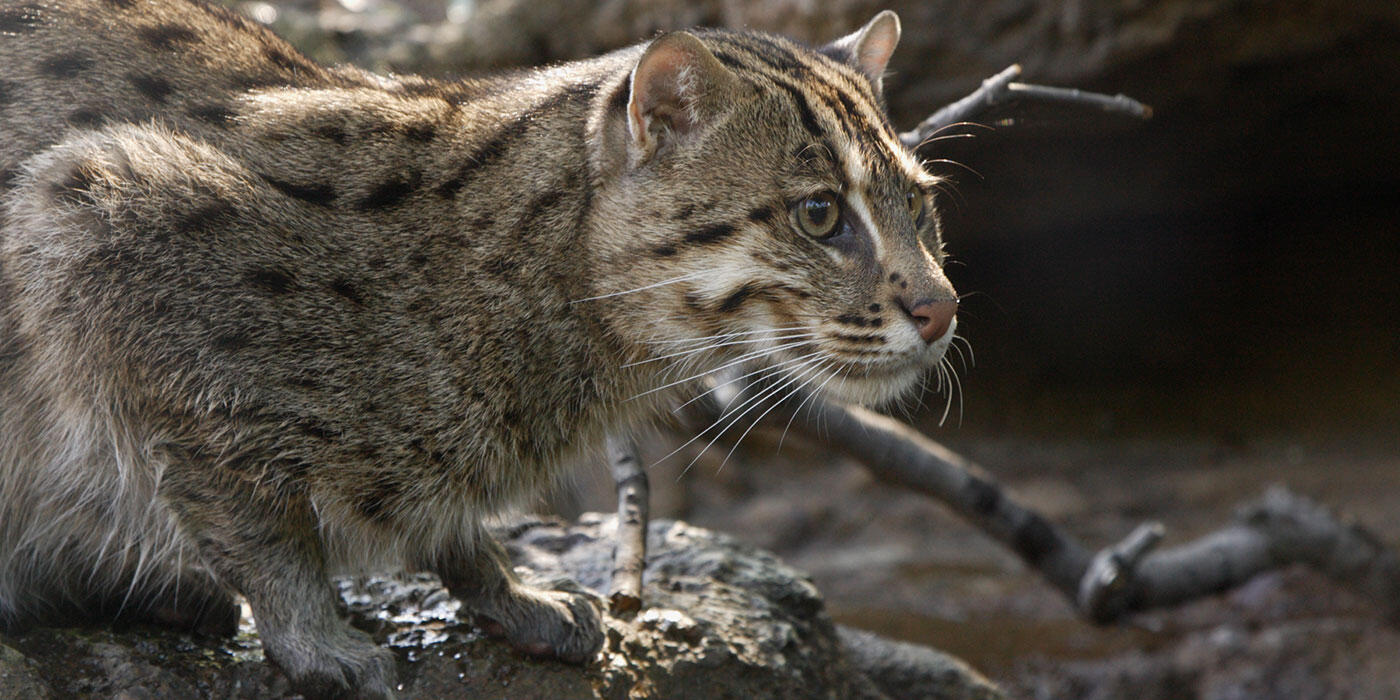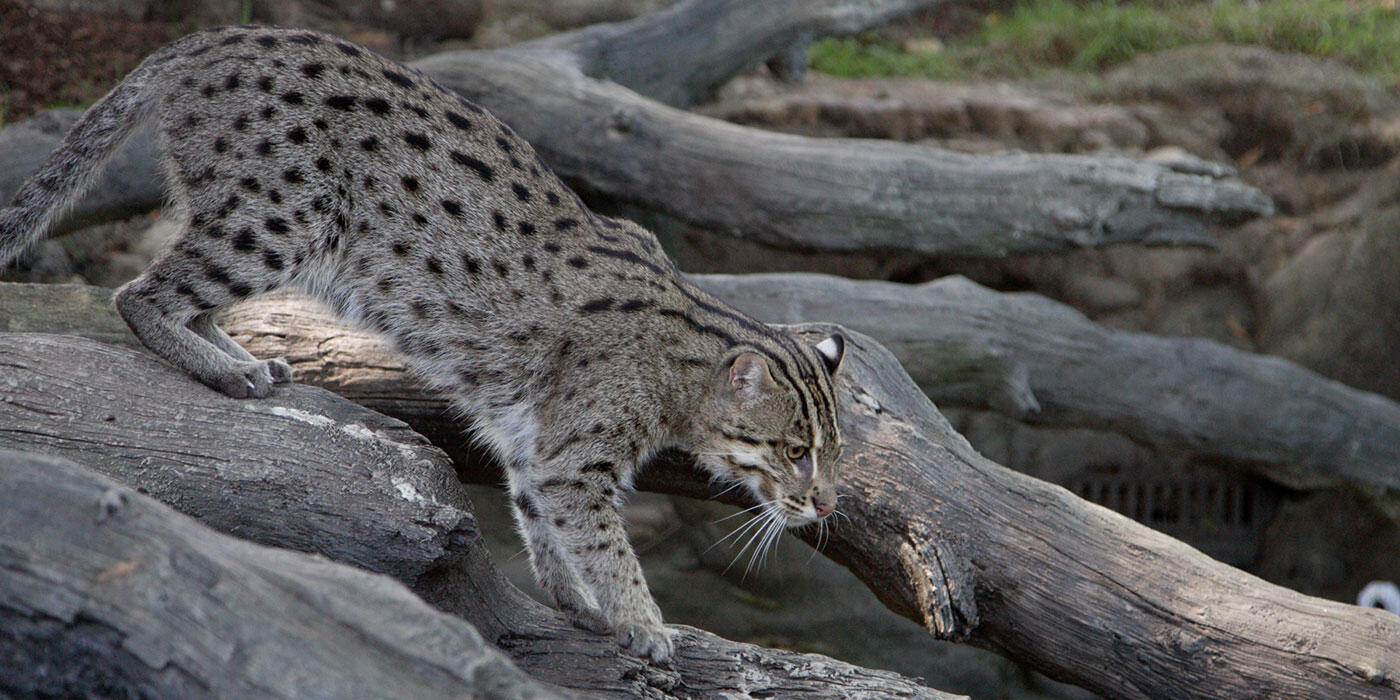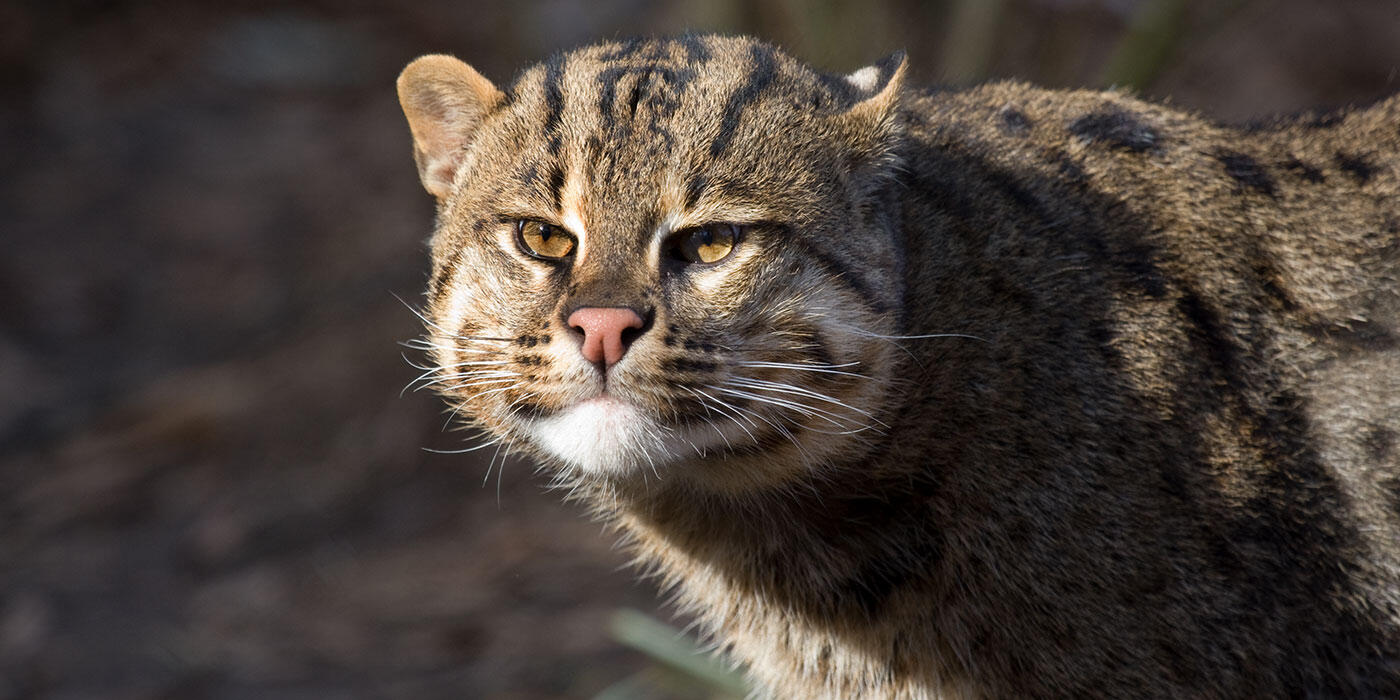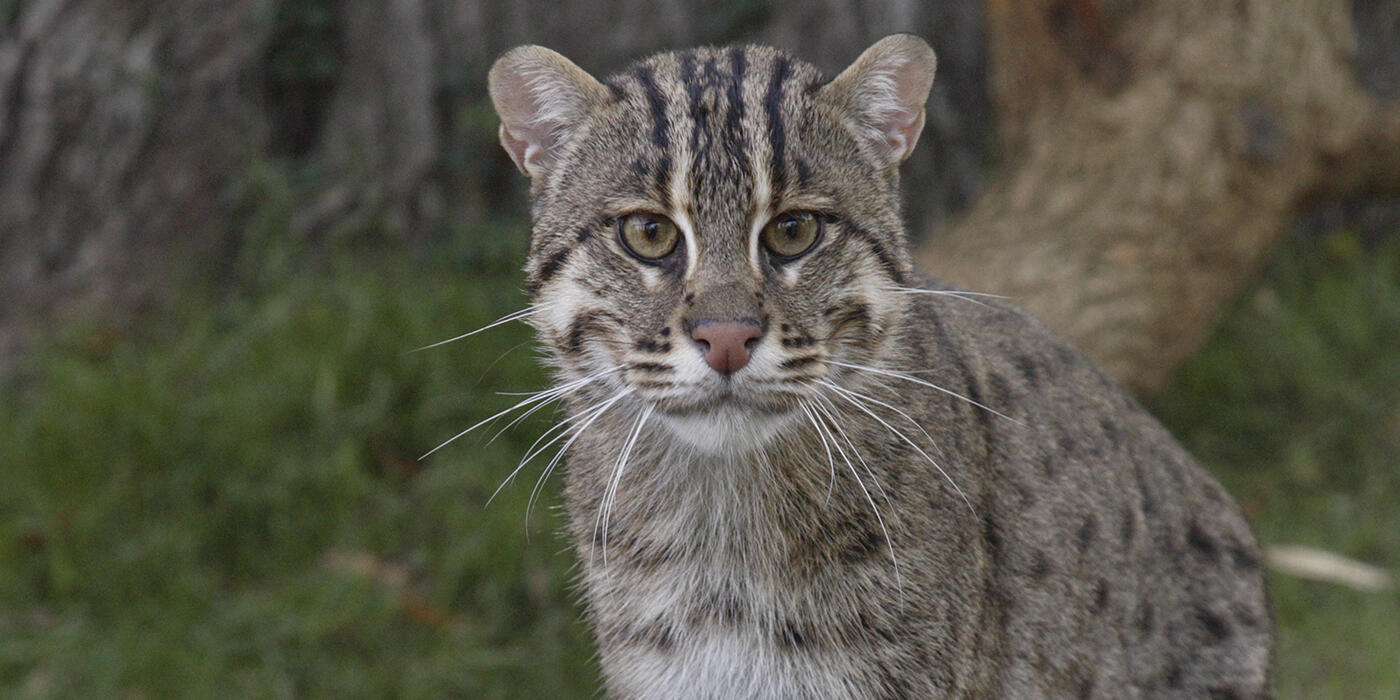Fishing cats are native to southern Asia. Very little is known about the behavior, habitat, population and habits of these elusive, nocturnal felines.
Physical Description
The fishing cat's coat is a camouflaged gray-brown with distinctive black spots and stripes. Six to eight black lines run from the cat's forehead to its neck, breaking up into shorter bars and spots on its shoulders. Its cheeks have white highlights and black marks, and its eyes are ringed with white fur. The ears are short and round, and the back of the ears are black. When viewed from the front, they have a distinctive white spot in the center.
The fishing cat's nose is pink or deep-brick in color. Its lips, chin, belly and throat are white with gray spots. The fur on its underside is longer and spotted. Its low-set, muscular tail is shorter than a domestic cat's and ringed with six or seven incomplete dark bands, distinguishing it from the leopard cat.
This cat is powerfully built with short limbs and a stocky body. Its head is round and elongated. Unlike many cats, fishing cats readily swim. Their front toes are partially webbed and their claws protrude slightly even when retracted. This facilitates the capture of prey, especially while underwater.
Another unique adaptation for their semiaquatic lives is the structure of their fur. A compact, dense layer of fur right against the cat’s skin is composed of tightly packed strands of hair, which prevents water from reaching the cat’s skin, keeping it warm in chilly waters. Long guard hairs protrude from this coat, giving the fishing cat its unique pattern.
Size
The fishing cat is one of the largest of the 28 species of small cats. This robust, deep‐chested cat has a body length of 33-45 inches (85-115 centimeters) and stands over 16 inches (40 centimeters) at shoulder height. The adult male weighs 18-31 pounds (8-14 kilograms), whereas the female is slightly smaller and weighs about 11-20 pounds (5-9 kilograms).
Native Habitat
The fishing cat's natural range is unknown, but it is currently found across South and Southeast Asia. The western reaches of its range extend into Pakistan, cutting east to Cambodia. The northern part of its range extends to the Himalayan foothills, which runs south to Sri Lanka and Thailand.
Reports of fishing cats are sporadic and, in a few cases, unreliable. But camera traps have confirmed their presence in some parts of their range, including some protected areas in India, along the coast of Sri Lanka, Bangladesh, and in the Mekong Delta of Vietnam. The last recorded camera trap capture in Vietnam was in 2000. There are reports of fishing cats spotted in urban areas of Sri Lanka. Separate reports place fishing cats in the north coast of Java, but biologists have not seen the species there since, and the population known to live in Ujung Kulon National Park died from poisoning in 2006.
Fishing cats are generally found in wetland areas, such as marshes, swamps and mangrove forests. Their habitat is also linked with species of rodents that they eat, particularly the sensu lato (Rattus rattus). In some parts of the fishing cat’s range, these rodents intersect with areas that are rapidly urbanizing.
Fishing cats can also be seen in cultivated grasslands and agricultural areas with standing water. More recent studies show a rising population of fishing cats in more urban areas. This may not be the result of fishing cats extending their range into urban areas, but rather the encroachment of human development into the wetland areas they rely on.
Lifespan
Fishing cats can live into their late teens in human care. Life span in the wild is unknown but is presumably much shorter.
Communication
A solitary male will be attracted to a solitary female by her chorus of yowls and screeches.
Food/Eating Habits
Fishing cats are generalists, meaning they opportunistically feed on what is available. They primarily eat small mammals and fish. Birds also constitute a small portion of their diet. They have been observed eating shellfish, as well as other small prey, such as lizards and amphibians. They have also been known to feed on livestock, especially poultry.
In the wild, these cats "fish" at the edge of bodies of water. They appear to scoop their prey from the depths of the water and have also been observed playing with fish in shallow water.
The Smithsonian's National Zoo’s fishing cats eat prepared meat and feline dry diets, a variety of small fish (including smelt, capelin and herring), whole prey items (including rabbits and rats) and beef knuckle bones. Live goldfish are provided daily for enrichment in their indoor and outdoor pools. Here and elsewhere in human care, fishing cats have been observed dropping their food in the water, retrieving it and then eating it.
Social Structure
Little is known about the social structure of this species in the wild, but it is assumed that (like most other cats) they are primarily solitary, except for periods of breeding and rearing young.
Reproduction and Development
One to four kittens are born after a gestation of about 65 days. Birthing occurs in the warmest part of the year. Kittens are born blind and are nursed by their mother until they are about 6 months old. They reach adult size at about 8 1/2 months old and usually leave their mother when they are about 10 months old.
They become sexually mature around 18 months. In human care, females exposed to natural daylight are reproductively active throughout the year and tend to cycle monthly. Some experience a pseudopregnancy period, where their hormones mimic a pregnancy and they do not cycle for about two months. Spontaneous ovulation in the females occurs about 57 percent of the time, making artificial insemination difficult. Fishing cats are sexually mature at 1.5-2 years old.
Males in human care have been observed helping females rear and care for the young, but it's unclear whether they repeat this behavior in the wild.
Conservation Efforts
Fishing cats are threatened by human development in wetland areas. In much of their geographic range, humans carve a life out of the land in underdeveloped areas, including foothills, coastal forests, swamps and intertidal marshes. Human population in these areas is rapidly growing, while resources are diminishing. Increased pressure results in the expansion of human settlements into sparse areas, such as wetlands.
Additionally, deforestation for logging operations reduces the land’s capacity to recharge its water supply and maintain soil health. Without trees and natural vegetation, silt can accumulate too quickly and erode waterways. Silt, along with human products like effluent, trash and chemical pollution and agricultural runoff, washes downstream and settles in bodies of still water, which alters the landscape by filling in marshes and wetlands. These compounding factors isolate fishing cat populations drive local extinctions of fishing cats, isolate populations, and declines in remaining wild populations.
Fishing cats are also threatened by poaching to prevent livestock predation. Urban areas are also encroaching on fishing cat habitat. Researchers working with the Smithsonian looked at the impacts of urbanization on fishing cats. Among other impacts, they found that fishing cats are now becoming roadkill. Excessive runoff pollutes water sources and kills or contaminates fish, a prey item for fishing cats. The fishing cat is also a victim of poaching for its fur, as well as incidental poisoning.
Fishing cats are considered an “indicator species,” meaning their presence or absence indicates how a whole ecosystem is functioning. This is because the cats play such a significant role in controlling a complex food chain (called a “tropic cascade”) that is contingent on access to water. Their status in the wild is indicative of the health of the ecosystem they inhabit.
Their population has declined at an estimated 30 percent over the last 15 years, and it is likely than an additional decrease of 30 percent over the next 15 years will occur. These cats are legally protected in Bangladesh, Cambodia, India, Indonesia, Lao PDR, Myanmar, Pakistan, Sri Lanka, Thailand and Vietnam.
Help this Species
Be a smart consumer! Avoid animal-skin products, even those marked “faux,” to ensure you’re not contributing to the illegal hunting of this species.
Practice ecotourism by being an advocate for the environment when you’re on vacation. During your travels, support, visit or volunteer with organizations that protect wildlife. Shop smart too! Avoid buying products made from animals, which could support poaching and the illegal wildlife trade.
Support organizations like the Smithsonian’s National Zoo and Conservation Biology Institute that research better ways to protect and care for this animal and other endangered species. Consider donating your time, money or goods.
Share the story of this animal with others. Simply raising awareness about this species can contribute to its overall protection.
Meet the Animals
Two male fishing cats live on Asia Trail. Their names are Hunter and Angler.
Smithsonian's National Zoo and Conservation Biology Institute. (n.d.). Fishing cat. Retrieved January 9, 2026, from https://nationalzoo.si.edu/animals/fishing-cat
Animal News

Meet Our Tiny Terrapin Hatchling ›





